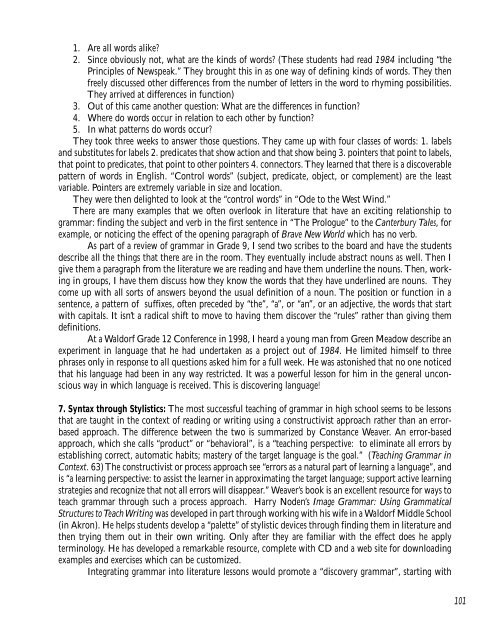Colloquium on English - Research Institute for Waldorf Education
Colloquium on English - Research Institute for Waldorf Education
Colloquium on English - Research Institute for Waldorf Education
You also want an ePaper? Increase the reach of your titles
YUMPU automatically turns print PDFs into web optimized ePapers that Google loves.
1. Are all words alike?<br />
2. Since obviously not, what are the kinds of words? (These students had read 1984 including “the<br />
Principles of Newspeak.” They brought this in as <strong>on</strong>e way of defining kinds of words. They then<br />
freely discussed other differences from the number of letters in the word to rhyming possibilities.<br />
They arrived at differences in functi<strong>on</strong>)<br />
3. Out of this came another questi<strong>on</strong>: What are the differences in functi<strong>on</strong>?<br />
4. Where do words occur in relati<strong>on</strong> to each other by functi<strong>on</strong>?<br />
5. In what patterns do words occur?<br />
They took three weeks to answer those questi<strong>on</strong>s. They came up with four classes of words: 1. labels<br />
and substitutes <strong>for</strong> labels 2. predicates that show acti<strong>on</strong> and that show being 3. pointers that point to labels,<br />
that point to predicates, that point to other pointers 4. c<strong>on</strong>nectors. They learned that there is a discoverable<br />
pattern of words in <strong>English</strong>. “C<strong>on</strong>trol words” (subject, predicate, object, or complement) are the least<br />
variable. Pointers are extremely variable in size and locati<strong>on</strong>.<br />
They were then delighted to look at the “c<strong>on</strong>trol words” in “Ode to the West Wind.”<br />
There are many examples that we often overlook in literature that have an exciting relati<strong>on</strong>ship to<br />
grammar: finding the subject and verb in the first sentence in “The Prologue” to the Canterbury Tales, <strong>for</strong><br />
example, or noticing the effect of the opening paragraph of Brave New World which has no verb.<br />
As part of a review of grammar in Grade 9, I send two scribes to the board and have the students<br />
describe all the things that there are in the room. They eventually include abstract nouns as well. Then I<br />
give them a paragraph from the literature we are reading and have them underline the nouns. Then, working<br />
in groups, I have them discuss how they know the words that they have underlined are nouns. They<br />
come up with all sorts of answers bey<strong>on</strong>d the usual definiti<strong>on</strong> of a noun. The positi<strong>on</strong> or functi<strong>on</strong> in a<br />
sentence, a pattern of suffixes, often preceded by “the”, “a”, or “an”, or an adjective, the words that start<br />
with capitals. It isn’t a radical shift to move to having them discover the “rules” rather than giving them<br />
definiti<strong>on</strong>s.<br />
At a <strong>Waldorf</strong> Grade 12 C<strong>on</strong>ference in 1998, I heard a young man from Green Meadow describe an<br />
experiment in language that he had undertaken as a project out of 1984. He limited himself to three<br />
phrases <strong>on</strong>ly in resp<strong>on</strong>se to all questi<strong>on</strong>s asked him <strong>for</strong> a full week. He was ast<strong>on</strong>ished that no <strong>on</strong>e noticed<br />
that his language had been in any way restricted. It was a powerful less<strong>on</strong> <strong>for</strong> him in the general unc<strong>on</strong>scious<br />
way in which language is received. This is discovering language!<br />
7. Syntax through Stylistics: The most successful teaching of grammar in high school seems to be less<strong>on</strong>s<br />
that are taught in the c<strong>on</strong>text of reading or writing using a c<strong>on</strong>structivist approach rather than an errorbased<br />
approach. The difference between the two is summarized by C<strong>on</strong>stance Weaver. An error-based<br />
approach, which she calls “product” or “behavioral”, is a “teaching perspective: to eliminate all errors by<br />
establishing correct, automatic habits; mastery of the target language is the goal.” (Teaching Grammar in<br />
C<strong>on</strong>text. 63) The c<strong>on</strong>structivist or process approach see “errors as a natural part of learning a language”, and<br />
is “a learning perspective: to assist the learner in approximating the target language; support active learning<br />
strategies and recognize that not all errors will disappear.” Weaver’s book is an excellent resource <strong>for</strong> ways to<br />
teach grammar through such a process approach. Harry Noden’s Image Grammar: Using Grammatical<br />
Structures to Teach Writing was developed in part through working with his wife in a <strong>Waldorf</strong> Middle School<br />
(in Akr<strong>on</strong>). He helps students develop a “palette” of stylistic devices through finding them in literature and<br />
then trying them out in their own writing. Only after they are familiar with the effect does he apply<br />
terminology. He has developed a remarkable resource, complete with CD and a web site <strong>for</strong> downloading<br />
examples and exercises which can be customized.<br />
Integrating grammar into literature less<strong>on</strong>s would promote a “discovery grammar”, starting with<br />
101

















